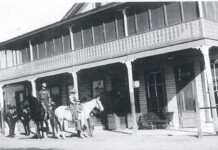
Italian-American Heritage Month is celebrated in Maricopa and across the country during October to honor and recognize the centuries of achievements, successes and valuable contributions of Italian immigrants and Italian Americans.
More than 5.4 million Italians came to the United States between 1820 and 2000. Currently, more than 26 million people of Italian descent live in America, making Italian-Americans the fifth-largest ethnic group in our nation.
According to Grand Voyage Italy, a travel blog with information about the history of Italians who emigrated to America, “packed like sardines” was a term commonly used to described immigrants of all nationalities making the trip by boat. It took as long as four weeks to travel to North America, plenty of time for passengers to fall ill. Although passengers had to pass a physical exam upon boarding to prevent the spread of disease, sickness was inevitable in such close quarters from the likes of marasmus, diarrhea, scarlet fever, tuberculosis and bronchial conditions made worse by the icy temperatures and dampness.
Before regulations were in place, there was not a large variety of food. Water was not very fresh for those in steerage and was used sparingly. The meals depended on the skill of the cook and the ingredients available. On early ships, food would be cooked by passengers in communal areas, a challenge on rough seas.
On arriving in America, immigrants clapped excitedly at the first sight of the Statue of Liberty in New York Harbor. People rushed to the side of the boat yelling, “Look at her … look at her!” They knew they had arrived in America.
As with Italians and other ethnic groups coming to the States, poverty was the main motivation to leave family and home and put up with the hardships of traveling to America.
Nearly 80% of Italians were farmers and couldn’t afford modern farming equipment to better their lives. Rural Italians lived in harsh conditions, residing in one-room houses with no plumbing or privacy.
According to the Italian Sons and Daughters of America, a group that works to preserve the history of Italian Americans, many Italians didn’t own land. “So, they were indebted to landlords, who charged high rents and took a portion of their crops. An Italian contadino who farmed year-round might earn 16-30 cents per day in Italy. A carpenter in Italy would receive 30 cents to $1.40 per day, making a 6-day week’s pay $1.80 to $8.40. In America, a carpenter who worked a 56-hour week would earn $18.”
Many immigrants from Italy and other lands suffered – and endured. Both immigrant peasants and those with skills faced economic as well as ethnic prejudices as they entered the labor force in America. They helped to build this country. They helped defend it. They assimilated. They became citizens, paid taxes, sent their kids to school, worked hard to build a better life for their families.
Give a tip of the cap this month to your Maricopa Italian American friends and neighbors.
Joan Koczor is a senior advocate and a member of the Age-Friendly Maricopa Advisory Board.












![Alleged car thief released without charges Phoenix police stop a stolen vehicle on April 20, 2024. [Facebook]](https://www.inmaricopa.com/wp-content/uploads/2024/04/IMG_5040-218x150.jpg)




